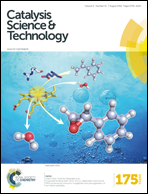Twin-like ternary PtCoFe alloy in nitrogen-doped graphene nanopores as a highly effective electrocatalyst for oxygen reduction†
Abstract
Considerable advances have been achieved in the synthesis of Pt-based alloys for oxygen reduction reaction (ORR). However, early transition metals are vulnerable to dissolution, and the attained durability performance of ORR remains unsatisfactory. Here, a novel twin-like ternary PtCoFe alloy encapsulated in nitrogen-doped graphene nanopores (PtCoFe/NPG) was fabricated using platinum phthalocyanine (PtPc), iron phthalocyanine (FePc), and cobalt phthalocyanine (CoPc) as precursors. These metal Pc provided abundant nitrogen sources and facilitated the carbon supports doped with nitrogen during calcination. Most PtFeCo alloy nanoparticles are uniformly confined in the graphene nanopores. This composite markedly decreases Pt usage; the mass activity of PtCoFe/NPG 700 is 7.6 times higher than that of the commercial 20% Pt/C electrocatalyst, and the electrochemical durability of PtCoFe/NPG exhibits slow decay with a high current retention of 94.6%. The improved ORR catalytic performance of PtCoFe/NPG could be attributed to the synergy and strong electronic interaction between the twin-like PtCoFe alloy and the graphene nanopores. In addition, the large surface area and the formation of particular N–M bonds positively affected its ORR activity. This study opens up a new avenue for developing a variety of metal/graphene nanopore hybrids for potential use in energy devices and other technological devices.


 Please wait while we load your content...
Please wait while we load your content...